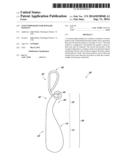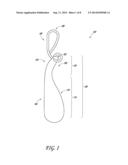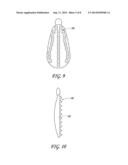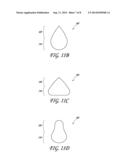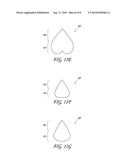Patent application title: COUNTERWEIGHT FOR JEWELRY PENDANT
Inventors:
Amy Gross (Huntington Beach, CA, US)
IPC8 Class: AA44C2500FI
USPC Class:
63 23
Class name: Jewelry watch or chain attachment charm
Publication date: 2014-09-11
Patent application number: 20140250948
Abstract:
A counterweight pendant for a necklace comprises a bottom portion with a
substantially flat back surface and a top portion that joins the bottom
portion at an angle or curve. The back surface is configured to
frictionally rest against a person's back and may be textured. The curved
top portion of the counterweight allows a necklace clasp to be attached
without interfering with the area of friction against the back surface
and the person's back. The bottom portion can be wider and contain more
mass than the top portion to keep the counterweight in the proper
orientation.Claims:
1. A counterweight pendant for use with a necklace comprising: a pendant
body having a bottom portion comprising a substantially flat back surface
configured to rest against a user's back when worn, the pendant body
further having a top portion configured to couple a clasp for coupling
the pendant body to a rear portion of the necklace, wherein a back
surface of the top portion extends away from a plane defined by the
substantially flat back surface so that the top portion is spaced apart
from the user's back when the counterweight is worn, wherein the back
surface of the bottom portion is textured, the bottom portion is wider
than the top portion, and wherein the bottom portion contains more mass
than the top portion to thereby inhibit tilting or twisting of the
pendant body away from the user's back during use.
2. The counterweight pendant of claim 1, wherein the back surface of the top portion joins the substantially flat back surface at an angle.
3. The counterweight pendant of claim 1, wherein the top portion curves outwardly from the substantially flat back surface such that the top portion extends away from said plane.
4. The counterweight pendant of claim 1, wherein the bottom portion comprises an ellipsoid shape.
5. The counterweight pendant of claim 1, wherein the textured surface comprises an epoxy layer that defines one or more peaks.
6. The counterweight pendant of claim 1, wherein the top portion terminates in a tip.
7. A counterweight pendant for use with an encircling body ornament, comprising: a pendant body having a bottom portion comprising a substantially flat back surface configured to rest against a user's back when worn, the pendant body further having a top portion configured to couple a clasp for coupling the pendant body to the encircling body ornament, wherein a back surface of the top portion extends away from a plane defined by the substantially flat back surface so that the top portion is spaced apart from the user's back when the counterweight is worn, wherein the back surface of the top portion is spaced apart from the substantially flat back surface to facilitate frictional engagement between the flat back surface and the user's back during use and inhibit tilting or twisting of the pendant body away from the user's back during use.
8. The counterweight of claim 7, wherein the encircling body ornament is a necklace, wherein the clasp is a necklace clasp configured to couple the pendant body to a rear portion of the necklace.
9. The counterweight pendant of claim 7, wherein the back surface of the top portion joins the substantially flat back surface at an angle.
10. The counterweight of claim 7, wherein the top portion curves outwardly from the substantially flat back surface such that the top portion curves away from said plane.
11. The counterweight of claim 7, wherein the bottom portion comprises an ellipsoid shape.
12. The counterweight of claim 7, wherein the bottom portion is wider than the top portion to inhibit twisting of the pendant body during use.
13. The counterweight of claim 7, wherein the bottom portion contains more mass than the top portion to inhibit movement of the pendant body during use.
14. The counterweight of claim 7, wherein the back surface of the bottom portion is textured to facilitate frictional engagement between the pendant body and the user's back during use.
15. The counterweight of claim 14, wherein the textured surface comprises an epoxy layer that defines one or more peaks.
16. A body ornament for use with a necklace, comprising: a necklace clasp; and a counterweight pendant comprising: a pendant body having a bottom portion comprising a substantially flat back surface configured to rest against a user's back when worn, the pendant body further having a top portion configured to couple a clasp for coupling the pendant body to a rear portion of the necklace, wherein a back surface of the top portion extends away from a plane defined by the substantially flat back surface so that the top portion is spaced apart from the user's back when the counterweight is worn to thereby facilitate contact between the substantially flat back surface and the user's back during use.
17. The body ornament of claim 16, wherein the top portion is removably attached to the clasp.
18. The counterweight pendant of claim 16, wherein the back surface of the top portion joins the substantially flat back surface at an angle.
19. The body ornament of claim 16, wherein the top portion curves outwardly from the substantially flat back surface such that it extends away from said plane.
20. The body ornament of claim 16, wherein the back surface of the bottom portion is textured.
Description:
BACKGROUND
[0001] 1. Field
[0002] The invention relates to body ornaments, and more particularly, to counterweights attachable to jewelry (e.g., necklaces).
[0003] 2. Description of the Related Art
[0004] When a person wears a necklace, it frequently shifts position due to normal body movement. Further, forces such as the wind and weather may also cause the necklace to change position. In addition, when the necklace includes a pendant, the pendant can fling around, causing discomfort to the user. The pendant can also move to an undesirable position, such as the back of a person's neck.
SUMMARY
[0005] Accordingly, there is a need for an improved counterweight that attaches to the back of a necklace at the user's back and can stabilize and anchor a necklace and pendant, inhibiting their movement during use.
[0006] In one embodiment of the invention, counterweight pendant for use with a necklace comprises a pendant body having a bottom portion comprising a substantially flat back surface configured to rest against a user's back when worn. The pendant body may have a top portion configured to couple a clasp for coupling the pendant body to a rear portion of the necklace. A back surface of the top portion may extend away from a plane defined by the substantially flat back surface so that the top portion is spaced apart from the user's back when the counterweight is worn. The back surface of the bottom portion may be textured, the bottom portion may be wider than the top portion, and the bottom portion may contain more mass than the top portion to thereby inhibit tilting or twisting of the pendant body away from the user's back during use. The back surface of the top portion may join the substantially flat back surface at an angle. The top portion may curve outwardly from the substantially flat back surface such that the top portion extends away from said plane. The bottom portion may comprise an ellipsoid shape. Textured surface may comprise an epoxy layer that defines one or more peaks. The top portion of the pendant body may terminate in a tip.
[0007] In one embodiment of the invention, a counterweight pendant for use with an encircling body ornament comprises a pendant body having a bottom portion comprising a substantially flat back surface configured to rest against a user's back when worn. The pendant body may further have a top portion configured to couple a clasp for coupling the pendant body to the encircling body ornament. A back surface of the top portion may extend away from a plane defined by the substantially flat back surface so that the top portion is spaced apart from the user's back when the counterweight is worn. The back surface of the top portion may be spaced apart from the substantially flat back surface to facilitate frictional engagement between the flat back surface and the user's back during use and inhibit tilting or twisting of the pendant body away from the user's back during use.
[0008] The encircling body ornament may be a necklace, and the clasp may be a necklace clasp configured to couple the pendant body to a rear portion of the necklace. The back surface of the top portion may join the substantially flat back surface at an angle. The top portion may curve outwardly from the substantially flat back surface such that the top portion curves away from said plane. The bottom portion may comprise an ellipsoid shape. The bottom portion may be wider than the top portion to inhibit twisting of the pendant body during use. The bottom portion may contain more mass than the top portion to inhibit movement of the pendant body during use. The back surface of the bottom portion may be textured to facilitate frictional engagement between the pendant body and the user's back during use. The textured surface may comprise an epoxy layer that defines one or more peaks.
[0009] In one embodiment of the invention, a body ornament for use with a necklace comprises a necklace clasp and a counterweight pendant comprising a pendant body. The pendant body may have a bottom portion comprising a substantially flat back surface configured to rest against a user's back when worn, and a top portion configured to couple a clasp for coupling the pendant body to a rear portion of the necklace. A back surface of the top portion may extend away from a plane defined by the substantially flat back surface so that the top portion is spaced apart from the user's back when the counterweight is worn to thereby facilitate contact between the substantially flat back surface and the user's back during use. The top portion may be removably attached to the clasp. The back surface of the top portion may join the substantially flat back surface at an angle. The top portion may curve outwardly from the substantially flat back surface such that it extends away from said plane. The back surface of the bottom portion may be textured.
BRIEF DESCRIPTION OF THE DRAWINGS
[0010] FIG. 1 is a side view of one embodiment of a counterweight attached to one embodiment of a clasp.
[0011] FIG. 2 is a side view of another embodiment of a counterweight attached to one embodiment of a clasp.
[0012] FIG. 3 is a side view of another embodiment of a counterweight attached to one embodiment of a clasp.
[0013] FIG. 4 is a side view of another embodiment of a counterweight attached to one embodiment of a clasp.
[0014] FIG. 5 is a side view of another embodiment of a counterweight attached to one embodiment of a clasp.
[0015] FIG. 6 a side view of another embodiment of a counterweight attached to one embodiment of a clasp.
[0016] FIG. 7 is a back view of one embodiment of a counterweight with a textured back surface.
[0017] FIG. 8 is a side view of one embodiment of a counterweight with a textured back surface.
[0018] FIG. 9 is a back view of another embodiment of a counterweight.
[0019] FIG. 10 is a side view of the counterweight of FIG. 9.
[0020] FIG. 11A-G illustrate front views of various embodiments of a counterweight.
DETAILED DESCRIPTION
[0021] In order to increase comfort to the user and increase effectiveness of a counterweight in stabilizing the position of a necklace, the embodiments disclosed herein provide a greater area of friction between the user and the counterweight.
[0022] Accordingly, some embodiments of the invention include a counterweight with a curved top portion, allowing room for a clasp to attach without disrupting the frictional area between the user and the counterweight (e.g., without tilting the counterweight away from contact with the user's back). Further, the counterweight may be textured to increase friction (e.g., the coefficient of friction) between the user and the counterweight. Even further, the bottom of the counterweight may be heavier and larger than the top of the counterweight so that the counterweight remains in the proper orientation. Additionally, the bottom of the counterweight can have a greater width than the top of the counterweight to thereby advantageously inhibit tilting of the counterweight away from contact with the user's back (e.g., due to the greater moment of inertia of the bottom portion).
[0023] Although examples are provided with reference to a necklace, the counterweight may be used with bracelets, anklets, waist chains, cords, collars, or any similar encircling body ornament. Further, while examples are provided with reference to a person or user, the counterweight may be used with any appropriate "wearer," such as animals, mannequins, and displays. In addition, it will be appreciated that the embodiments disclosed herein may be used as a pendant on the front of a necklace worn by a user. Thus, the embodiments disclosed herein are not limited to a counterweight worn on the back of a necklace. Accordingly, as used herein, "counterweight" shall refer to a pendant body that may be worn as a pendant on the front of a necklace or as a counterweight on the back of a necklace.
[0024] FIGS. 1-4 illustrate side views of various embodiments of a pendant assembly 100. The pendant assembly 100 can include a clasp 180 and a pendant body 190 (e.g., counterweight). In addition, the pendant body 190 (e.g., counterweight) can include a top portion 120, bottom portion 110, top back surface 130, bottom back surface 140, top front surface 160, bottom front surface 170, and tip 150. The top back surface 130 and bottom back surface 140 are the portions of the pendant body 190 that contact the user (e.g., user's skin or user's clothing) during use. The pendant body 190 can be made of metal (e.g., silver, gold). However, in other embodiments, the pendant body 190 can be made of other suitable materials. The counterweight 190 is dimensioned so that the bottom back surface 140 rests against a person's back. The counterweight 190 may attach to a necklace through the clasp 180 or any other suitable mechanism. Examples include a lobster clasp, jump ring, ring, hook, and s-hook. As used herein, "clasp" 180 refers to any or all of the above.
[0025] Referring to FIGS. 1-4, the top portion 120 is generally angled (e.g., raised or curved) with respect to the bottom portion 110. In some embodiments, the top back surface 130 meets the bottom back surface 140 at an angle (see e.g., FIGS. 2, 4). In one embodiment, as illustrated in FIG. 1, the top portion 120 curves outwardly from the bottom back surface 140 in the direction of the bottom front surface 140, and the top portion 120 terminates at the tip 150 of the counterweight 190. The bottom back surface 140 is substantially flat so that it may rest against a person's back. Thus, seen from the side, the bottom back surface 140 of the counterweight 190 appears generally as a straight line.
[0026] Still referring to FIGS. 1-4, the front surface 160, 170 along the length of the counterweight 190 may follow any curvature. For example, the front surface may be flat, round, convex, concave, angled, steep, or any combination thereof. FIG. 2 illustrates one embodiment of a counterweight 190 with a constant flat front surface 160, 170. FIG. 4 illustrates a front surface 160, 170 with a flat surface that protrudes toward the bottom, is recessed toward the middle, and angled toward the top. In one embodiment, as illustrated in FIGS. 1 and 3, the bottom front surface 170 is generally round and convex. In one embodiment, the top front surface 160 generally follows the curvature of the top back surface 130 (see FIGS. 1, 3, and 4). In one embodiment, the curvature of the top front surface 120 and top back surface 130 are different (see FIG. 2).
[0027] Referring to FIG. 3, the top portion 120 may curve or angle outwardly, then curve or angle inwardly toward the bottom back surface 140, but the tip 150 of the counterweight 190 does not cross a plane defined by the bottom back surface 140. Thus, along the length of the top portion 120, the back surface 130 is oriented in front (or spaced apart forwardly) of the bottom back surface 140. Thus, the top portion 120 can be spaced apart from a user's back when the counterweight 190 is worn.
[0028] Regardless of the shape of the front surface 160, 170, the top back surface 130 is spaced apart from a plane defined by the bottom back surface 140. In one embodiment, the top back surface meets the bottom back surface 140 at an angle that faces away from a user's back. In another embodiment, the top back surface 130 curves away from the plane defined by the bottom back surface 140, such that the top portion 120 extends away (or is spaced away) from said plane. In one embodiment, the counterweight 190 is generally teardrop in shape, as illustrated in FIGS. 1 and 11A. Referring to FIG. 1, the top portion 120 curves outwardly and the bottom portion 110 is concave, with the thickness and curvature increasing toward the bottom of the counterweight 190, thereby forming a teardrop shape.
[0029] Because the top portion 120 is offset in front of the bottom portion 140, a clasp 180 may be attached to the tip 150 while allowing the entire bottom back surface 140 to rest flat against a person's back. The offset top portion 120 advantageously allows the clasp 180 to attach to the counterweight 190 without causing the back surface 140 to tilt away (e.g., lift away) from the user's back, thereby advantageously facilitating maximum frictional contact between the back surface 140 of the user's back during use, as shown in FIG. 1. Accordingly, a clasp 180 may be advantageously attached to the counterweight 190 without reducing the area of friction between the user and the counterweight 190. The increased frictional area helps keep the counterweight 190 in place and adds stability. In addition, returning to FIG. 1, a clasp 180 may have a back surface 182 that is substantially flat and aligns with the bottom back surface 140, so that both back surfaces 182, 140 lay flat against a user's back when worn (e.g., generally extend along the same plane).
[0030] The top portion 130 may be designed to accommodate any shape clasp 180. In addition, the top portion 130 may be specifically designed to accommodate a specific clasp 180. For example, for hooks with a high degree of curvature, or hooks that add significant thickness, the top portion 130 of the counterweight 190 can similarly be curved so that the clasp 180 does not interfere with the bottom back surface 140 resting against a person's back. FIGS. 5-6 illustrate how the top portion 130 may be varied depending on the shape of the clasp 180.
[0031] The counterweight 190 may be designed to receive a clasp 180 in any number of ways. Examples include a "hook and eye" mechanism, screws, wires, magnets, and snaps. The counterweight 190 can couple to a clasp 180 that is a necklace clasp included on a necklace. In another embodiment, a separate clasp may be used for attaching the counterweight 190 to a necklace. The separate clasp may be used when a necklace does not include a clasp. In one embodiment, a clasp 180 is integrally formed with the counterweight 190 so that it may be used with necklaces without a clasp. The counterweight 190 may also be integrally formed with a necklace.
[0032] In one embodiment, the back surface 140 is textured to increase the coefficient of friction between the counterweight 190 and the user's back and help keep the counterweight 190 in place. FIGS. 7-10 illustrate back and side views of a counterweight 190 with differently textured back surfaces 140. The back surface 140 may include bumps 720 (FIGS. 7-8) or peaks 710 (FIGS. 9-10) or any other texture for increasing friction. In one embodiment, an additional layer can be added to the back surface 140, thereby providing texture on the back surface 140. In one embodiment, an epoxy layer defining a plurality of peaks 710 is added to the back surface 140, as illustrated in FIGS. 9-10. The peaks 710 can advantageously grab onto a person's body, clothing, or skin, to facilitate fixation of the counterweight. The texture on the back surface 140 (e.g., the texture provided by an additional layer) may be made of any other suitable material. Further, the textured back surface 140 need not include peaks 710. The back surface 140 may also be lined with a textured fabric, such as wool. The back surface 140 may comprise a variety of textures on the same counterweight 190. Thus the back surface 140 may include peaks 710 in some areas and bumps 720 in other areas. In one embodiment, textures may be formed on the counterweight 190 (e.g. during manufacture or after manufacture). Although the texture may add some irregularities to the back surface 140, the bottom back surface 140 remains substantially flat for resting against a person's back.
[0033] In one embodiment, the bottom portion 110 of the counterweight 190 contains more mass than the top portion 120. The distribution of mass advantageously helps keep the counterweight 190 in the proper orientation. For example, the distribution of mass prevents the bottom portion 110 from re-orienting itself over the top portion 120.
[0034] The bottom portion 110 can also be wider than the top portion 120 to advantageously help keep the counterweight 190 in the proper orientation (i.e., the bottom portion 110 can have a greater moment of inertia than the top portion, inhibiting twisting or lifting of the counterweight 190 relative to the user's back). FIGS. 11A-G illustrate front views of various embodiments of a counterweight 190 with bottom portions 110 wider than the top portions 120. Referring to FIGS. 11A-G, the shape of the counterweight 190 may be generally oval (e.g. FIGS. 11A, B, G), triangular (e.g. FIGS. 11C, F), pear shaped (e.g. FIG. 11D), resemble an upside down heart (e.g. FIG. 11E), or any other suitable shape wherein the bottom portion 110 is wider than the top portion 120.
[0035] While certain embodiments of the inventions have been described, these embodiments have been presented by way of example only, and are not intended to limit the scope of the disclosure. Indeed, the novel methods and systems described herein may be embodied in a variety of other forms. Furthermore, various omissions, substitutions and changes in the form of the pendant or counterweight systems and methods of making them described herein may be made without departing from the spirit of the disclosure. The accompanying claims and their equivalents are intended to cover such forms or modifications as would fall within the scope and spirit of the disclosure. Accordingly, the scope of the present inventions is defined only by reference to the appended claims.
User Contributions:
Comment about this patent or add new information about this topic:

